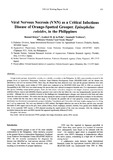Viral nervous necrosis (VNN) as a critical infectious disease of orange-spotted grouper, Epinephelus coioides, in the Philippines
Share
Abstract
Orange-spotted grouper, Epinephelus coioides, is a valuable commodity in the Philippines. In 2001, mass mortality occurred in the grouper larvae at Aquaculture Department, Southeast Asian Fisheries Development Center (SEAFDEC/AQD) and the disease was identified as viral nervous necrosis (VNN). Since then, the disease has been observed every year and the grouper hatcheries have been devastated. In this paper, recent studies of VNN which were conducted at the SEAFDEC/AQD from 2001 to 2006 are reviewed. 1) Susceptibility to the VNN virus was tested among fish species that were cultured in mangrove brackish are. Five representative cultured fish species including orange-spotted grouper, Asian sea bass (Lates calcarifer), mangrove red snapper (Lutjanus argentimaculatus), milkfish (Chanos chanos) and rabbitfish (Siganus guttatus) were used in the test where the virus was intraperitoneally injected into the juveniles. Although low or no mortality occurred in the challenge test, histopathological changes were observed in the brain and retina where the virus was re-isolated. The results were the same among the species except for rabbitfish which had no evidence for the infection. It was verified that the virus has a wide host range. 2) To estimate the possible risk of viral spread by vertical transmission, virus distribution was determined in asymptomatic groupers including 7 broodstock and 17 juveniles with body weights ranging from 4 to 12 kg and 2 to 9 respectively. The virus was detected by PCR method. The highest detection rate was in the brain, and the virus was also detectable in other organs such as the gills, heart, spleen, kidney, blood, esophagus, stomach, intestine, liver, gonad, swim bladder and/or skin. 3) As a possible VNN vaccine, a DNA p;asmid encoding the capsid protein of the virus was evaluated. After the challenge, the mortalities between the native and DNA-injected fish appeared significantly different (P<0.05).
Suggested Citation
Kiryu, I., de la Peña, L. D., Yoshiura, Y., Ototake, M., & Maeno, Y. (2007). Viral nervous necrosis (VNN) as a critical infectious disease of orange-spotted grouper, Epinephelus coioides, in the Philippines. In K. Nakamura (Ed.), Sustainable Production Systems of Aquatic Animals in Brackish Mangrove Areas (JIRCAS Working Report No. 56) (pp. 121-126). Tsukuba, Ibaraki, Japan: Japan International Research Center for Agricultural Sciences.


